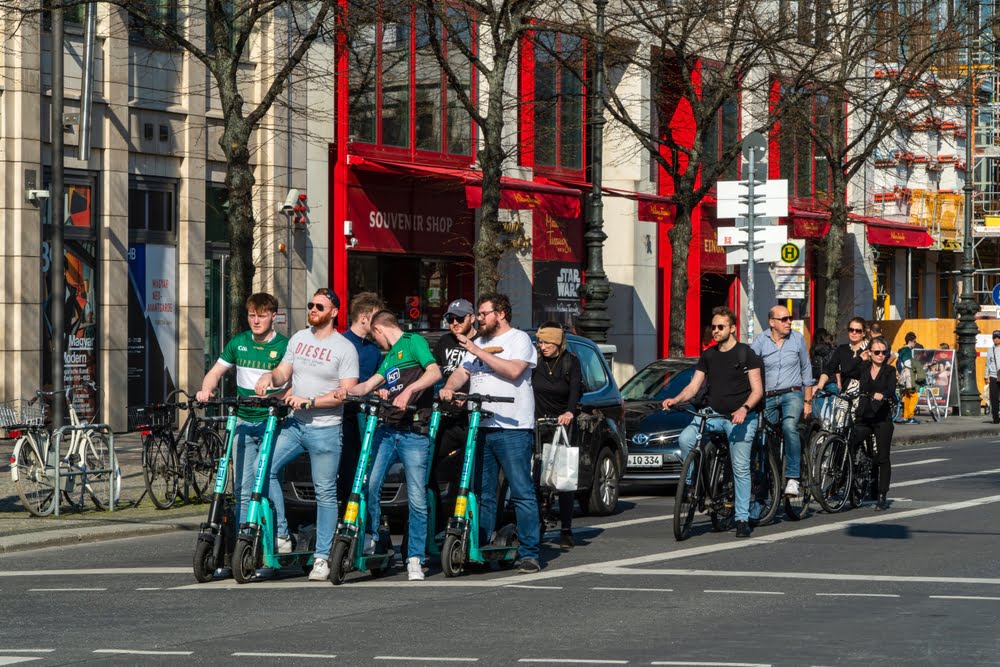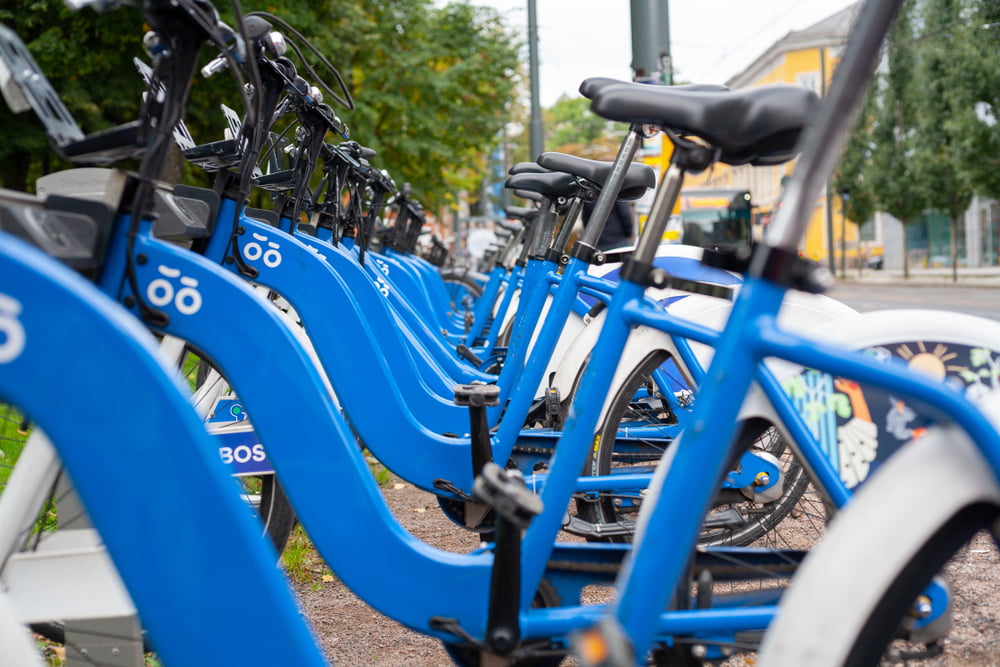A Public/Private Affair
As shared micromobility sweeps through cities, regulations and monitoring have become the preferred tools for taming its unruly nature. But are these rules truly unlocking the potential of micromobility or simply reining in its negative effects? In the five years that followed the arrival of floating e-scooters and e-bikes to European streets, many cities have been learning by doing. From prohibition to full-hearted adoption, and from open-door markets to highly competitive tenders, the landscape is quite varied.
The greatest challenge faced by local and regional governments in the domain of mobility is accelerating the shift to sustainable, safe, and equitable urban mobility. Facilitating such a modal shift relies on the investment in suitable infrastructures and the integration within the transport mix, as well as the availability of reliable, safe, and accessible services — all things that could be solved by the cooperation between public authorities and private operators.
No one-size-fits-all — but solutions for all
The current local and transport contexts and regulatory frameworks (or lack thereof) will lead cities to face shared micromobility challenges differently. The regulatory landscape for micromobility is still highly dynamic, with different approaches tailored to different local circumstances and competences. Ultimately, what cities should strive for, are regulatory frameworks that maximise the opportunities offered by micromobility, but also mitigate unavoidable negative externalities. Let's have a look at how some cities are working towards this in what is clearly an iterative and collaborative process.
Leuven / Belgium
Shared micromobility embedded in an ambitious climate-neutral strategy
With the LKN2030 project leading the way, Leuven is committed to becoming climate neutral by 2050. Central to this mission is a sustainable urban transport strategy that emphasises multimodal options, including shared mobility. To ensure order in public spaces, Leuven implemented a licensing system for shared micromobility operators, while avoiding free-floating services: the City established 41 strategically located mobility hubs, offering a variety of shared bikes, e-cargo bikes, and e-cars for residents to conveniently access. To encourage greater uptake, Leuven is developing a nudging plan and pilot campaign targeting residents both in the city centre and the suburbs. They are also subsidising cargo bike use, aiming to improve accessibility and inclusivity for all citizens, including immigrants, the elderly, and people with disabilities.

Shared micromobility in Leuven. Credit: Thierry Hebbelinck / Shutterstock
Looking ahead, Leuven envisions collaborating with local businesses to introduce e-bikes, without compromising traditional bicycle usage. They are also exploring peer-to-peer and community-based platforms as potential solutions for expanding shared mobility options.
Recognising the importance of digital integration, Leuven acknowledges the need for regional cooperation in this area. They understand that working on a regional scale is vital for cities of similar size.
Leuven is paving the way towards a sustainable future, where transport is greener, more efficient, and accessible to all.
Berlin / Germany
The right mix of push and pull measures to foster alternatives
Berlin is taking bold steps to transform its transport system through the 'Berliner Straßengesetz' (Berlin Road Act) regulatory framework. With responsibility shared among its 12 districts, the city aims to effectively manage public spaces, sidewalks, and parking lots.

Shared micromobility in Berlin. Credit: Mo Photography Berlin / Shutterstock
To address the problem of e-scooters and rental bikes blocking sidewalks, the Berlin Road Act was amended — this grants the City greater control over shared mobility services and paves the way for expansion beyond the city centre.
The amended law classifies e-scooters, rental bikes, and car-sharing as a 'special use of road land.' This enables the city to charge user fees, regulate the number of vehicles per provider, and control parking locations. Although initially opposed, some shared mobility operators have gradually opened up to these regulations.

A Jelbi station in Berlin. Credit: MO Photography Berlin / Shutterstock
Berlin is also implementing measures for better distribution of shared micromobility, including no-parking zones and increased parking spaces. Integration with public transport is also a priority, exemplified by the Jelbi mobility platform, an app that offers real-time traffic information, multiple transport options, and an integrated payment system.
While challenges remain, such as increasing private vehicle usage, Berlin aims to foster alternatives. Creating space for shared mobility, improving public transport, and discouraging private car usage through higher parking fees are key strategies. Lessons from Berlin's experience highlight the importance of finding a combination of solutions that address diverse opinions and realities, shaping a transportation system that meets the needs of users and the city.
Budapest / Hungary
High parking spots density keeps the door-to-door function alive
Complementing the existing bike-sharing service, e-scooters have attracted a combined user base of 200,000 in the City of Budapest. Budapest's Centre for Transport (BKK) has pursued three integration fronts: infrastructure, provider management, and digital integration through a common platform.
Parking has been a major focus, with BKK identifying optimal locations for micromobility points (mMPs) through network analysis. Implementation was smooth in BKK-managed areas but required negotiation with local districts where parking jurisdiction lies. Design standards were established to ensure consistency across all mMPs while allowing flexibility for innovation and maintaining the goal of covering densely populated areas with mMPs every 150 meters.

Budapest mobility points design. Credit: City of Budapest, BKK
BKK sees micromobility as an opportunity to convert car users into public transport passengers: cooperation with private operators, as well as the development of micromobility-friendly paths and the promotion of micromobility alternatives to private cars, are all crucial for the success and profitability of BKK's plan. Public engagement, including a campaign to name mMPs, has raised positive awareness among 80% of Budapest citizens, and digital integration with public transport route planners will be the next step — and the cherry on top.
Budapest's advice to other cities is to consider shared micromobility in their Sustainable Urban Mobility Plans (SUMPs), integrate it with public transport, and adapt solutions to local contexts.
Mandatory parking zones should be implemented, starting with cost-effective bike racks. Moreover, demand-driven expansion of parking capacity can demonstrate the active use of micromobility and justify further development.
Madrid / Spain
Ensuring the best services for citizens through precise criteria
When free-floating e-scooters arrived in Madrid in 2018, local authorities swiftly addressed the challenges they posed. All existing e-scooters were withdrawn, and a required authorisation system was established. Initially, 21 operators were authorised, but market contingencies led to one out of four remaining.

Shared micromobility in Madrid. Credit: Ivan Marc / Shutterstock
To ensure the best services for citizens, Madrid conducted a tender process to authorise a maximum of three companies kicking off activities in May 2023. The criteria were developed based on local government experiences, citizen suggestions, and input from e-scooter companies. The points-based system considered factors such as experience in other big cities, e-scooter technical certifications, removable electric batteries, prompt removal of damaged or unlawfully parked vehicles, integration with the Madrid Mobility 360 Platform, technological solutions for lawful riding and parking, awareness campaigns, practical classes, and adherence to environmental regulations.

E-scooters for rent next to a subway station in Madrid. Credit: Clemente Lasala / Shutterstock
Limits were set on the number of vehicles, with 6,000 in total and 2,000 per operator, to balance demand and prevent excessive parking. To address parking violations, new contracts now require user identification to clarify responsibility and reduce conflicts. Operating authorisations will be limited to three years, with a one-year extension possibility, followed by future tenders to ensure continuous improvement.
Sharing Madrid's experiences and implementing best practices is crucial for other cities considering e-scooter regulations and seeking to provide optimal services to their communities.
Oslo / Norway
De facto changing competition with cars

Shared micromobility in Oslo. Credit: Franco Francisco Maria / Shutterstock
In 2019, e-scooters were introduced in the City of Oslo, leading to unforeseen challenges. The City faced legal difficulties in banning operators and setting conditions for rental activities on public land, prompting an uncommon legislative procedure. The Parliament quickly adopted a law granting municipalities the right to limit shared micromobility based on specific purposes described in the national law. Oslo adopted a local regulation based on the new law, initially allowing multiple operators but limiting the number of vehicles to 8,000. However, this created unsustainable competition, resulting in an adjustment of the law. As of February 2022, the maximum number of operators has been set at three for the share of 8,000 vehicles.
While challenges persist, shared micromobility remains popular in Oslo, but overregulation can hinder its potential as a sustainable urban transport solution. Balancing regulation with education, training, and enforcement is essential to address behavioural issues effectively.

Blue bicycles lined up for rent in Oslo. Credit: Toby Tande / Shutterstock
Cities should prioritise investment in infrastructure, safety, and availability to encourage the use of shared micromobility. Collaborating with public transport companies and ensuring dedicated spaces near transit stops can enhance complementary use.
Oslo’s case shows that visible parking spots, rather than geofencing, prove effective for compliance. Also, transforming streets with small interventions, such as closing them for the summer or implementing dedicated bike lanes, can improve the efficiency (and competition) between different modes of transport.
Cities must focus on where micromobility can contribute positively, rather than solely restricting its usage. Governance plays a crucial role in making new mobility options align with policy goals and ensuring their success.
Conclusion
Cities’ strategies can differ and satisfy diverse needs. Nonetheless, having a purpose for regulating shared micromobility can determine the successful implementation of regulations. Identifying what this purpose is, and how to overcome the subsequent obstacles through adapted governance, can be found through enhanced public and private cooperation.
Stay tuned for POLIS' upcoming report on regulating micromobility! For more information, contact Pedro Homem de Gouveia at pgouveia@polisnetwork.eu.
Click here to read the article in its original format.
About the author
Lina Kabbaj is a political sciences and international relations student at Sciences Po Aix, actively involved in the environmental association of her school. She holds a particular interest in the social, environmental, and political implications of urban mobility. While working as a Projects and Policies Intern at POLIS, she focused mainly on micromobility and urban vehicle access regulations (UVARs).
